0 Comments
Farmers markets are a really interesting place to sell produce at. We as vendors and owners of our business are interacting with the very people that are using our products. It is inherently so different from other ways of selling because of this direct relationship and personal connection. When buying something in retail, you are speaking with an employee of a company, one who usually doesn’t have any real say in the business they are representing. I wanted to share some thoughts from the perspective of a small scale farmer who’s sold at farmers markets for over a decade, there are lots of things that stay the same over the years and of course some things that change too. I’m going to try to keep this brief (Hopefully!). One thing that I find interesting is that some market customers want to be greeted and some don’t! I can say hi to one person and they will quickly move along and the next person will smile and walk up closer. I try to determine who is going to want a moment to look around first and who will walk away if you don’t say hi quick enough. It is certainly something I would love to be able to determine if I could, and maybe some vendors have a better instinct on this than me. Just know if you’re a customer at a farmers market that vendors are there to tell you about their products and are happy to tell you what you need to know! Another thing I’ve noticed is that customers will very often not want to take the last bag of something, maybe because they’re worried about our display, well we brought it to sell it so please, take the last bag! This leads into some thoughts about marketing our table - more products on the table always looks better from the customers point of view. This is a tricky thing for small-scale farmers with an aim for sustainability, namely we do not want to waste food! Every pick day before market day we try to have a feel for how busy the market will be, how much we can sell. We always have produce left over at the end of the market, so how much do we want to bring back with us? How much can we eat ourselves? How can we limit the waste of what we harvest from our fields. These are questions we ask ourselves everytime. You may notice that at every farmers market there is atleast one farm that has a little bit of almost everything, this is not by accident. They know that the more variety they have on their table the more likely they will sell more of each thing, because customers like one-stop-shops. Often (but not always) these farmers bring produce from other farms in order to have these well rounded tables. They are doing what they can and need to in order to make a living. The more you can replicate the grocery store ideas of selling vegetables, generally the more you will sell because customers are used to buying vegetables this way. This means having lots of variety, but it also means having things in plastic and ideally, labelled. This leads to a big dilemma for small-scale farmers because we are sustainability-minded. We could bring equal amounts of unbagged heads of lettuce and bags of salad mix and we would for sure sell all the bagged lettuce within the first couple of hours and likely bring most of the unbagged heads of lettuce home with us. This has been demonstrated to us countless times! If we put the same salad mix in paper bags on the table, we’d probably sell even less than the unbagged lettuce. This is because it isn’t visible to passerbys, and no matter how intentional people want to be about sustainability, if they don’t know you have lettuce they won’t buy it from you. This of course is not true for your regular customers who come to you every week, but much of what you make in a day from your produce comes from people that are passing through or from out of town. This leads to a weird middleground for small-scale farmers, where you want to limit your plastic usage as much as possible, but you also want your farm to stay afloat financially. It can perhaps make you seem like you lack integrity or are dishonest. But the fact is, we farmers are trying to do what we can, when we can. If I could bring all our produce loose or in paper bags I of course would! But it is not just on the vendors to make this happen, customers have to make intentional choices to for us to be able to make sustainable choices. This has been changing slowly over the years, but the majority of customers will still choose the plastic bag of salad mix - this is not a judgement, just an observation. We are lucky with our CSA that we can do all in paper packaging, this has been asked for by many members and accepted happily by the others, and it works is because these members are getting these veggies in paper packaging without having to pick it out at a table, it’s just going straight to them. Speaking with people shopping at farmers market, we are not dealing with data, we are not dealing with statistics, we are dealing with real people with their own thoughts, feelings and experiences. It is personal in the way that retail grocery shopping can never be. This leads to another thought of wanting to be able to speak to people at their level of knowledge of plants and food. When I say there is all levels I literally mean it! Just in one market day I can go from speaking with someone who’s never even heard of an eggplant to another who lived on an island where they grafted eggplant branches onto a wild related species and prepared them in specific ways to that culture. There is all kinds of different knowledge levels of this stuff and it can be tricky at first to know where the person is at with this knowledge, so please don’t be offended if we as vendors misjudge it at first! We are trying, to meet everyone at their level of understanding but it does take alot of adaptability for sure. Hmm what else… if a vendor is sitting down, or not at their table, or eating, they will probably still want to help you, it doesn’t hurt to ask! Its just that we get tired and hungry at times haha. And alot goes into market day prep, it’s usually atleast one day of picking, washing and packing veggies, then there is getting to the market (which can be quite early for some), and setting up the table, then being there for several hours and talking to lots of different people, and then tear down and bringing it all back home. We still want to help you even if we’re sitting down, we’re just tired haha. Well that’s all I can think of at the moment, if you have any questions about what goes on in the mind of a farmers market vendor feel free to ask! Farmers markets are wonderful, dynamic places that let you interect and learn with the community in such a direct way. I hope that this has given you a little more insight into what goes on in the minds of people behind the tables! Every farm is run a bit differently, with different priorities in mind, different motivations and different goals. It is difficult to express in words what we do with our farm. The ideal scenario to communicate this with you, is for you to come down to the farm for a visit, spend some time in the fields and see the forest surrounding the fields. We do have an open invitation once a week during the warmer months, check out our page “A Place of Fruition” for more info. In lieu of that, I will try to put it into words here as best I can. Our farm is run with the natural world as our highest priority, what does this mean? This means every action we do on the farm is done with how it might impact the natural world in mind. This means we use no pesticides of any kind on our vegetables. It means we don’t use any chemical fertilizers. It means we try to eliminate food waste any way we can. There’s an important thing to talk about - food waste. What does that mean? It means something that was grown or raised up until the point that it is edible and ready to be used by humans… but then isn’t, for whatever reason. One huge contributor to this is the non-use of a vegetable with “blemishes”. The modern conventional model for vegetables has the absolute perfect looking vegetables for sale to the buyer: no bruises, no insect bites, nothing mis-shapen. Anything that does not meet these unnaturally high standards is considered a “2nd” if it does end up available to a buyer, however they are just as often simply left in the field - wasted. Many people have been trained by this system to only buy produce that looks perfect. If you’ve ever grown your own food, you know that a perfectly straight carrot takes the same amount of time, energy and nutrients to grow as a crooked one. And there is no difference in taste or nutrition. On our farm, we give you veggies with blemishes because they are still high-quality and it is a waste to simply throw them away. When you see that apple looking perfect in the grocery store, what you don’t see is all the pesticides on it, or the layer of wax on the outside of it, or the thousands of miles it travelled to get there, or all the fuel it took to get it here, or the living conditions of the people who harvested it, or the history of the land it was grown on - what nature, people or animals it displaced, you don’t see how cheaply it was sold to the all the middlemen between the farm and the store, how the store makes more on it than the farmer - and you don’t see all the apples at didn’t reach these high aesthetic standards to be on the shelf beside it. When you buy an apple from us, it is just an apple, no pesticides, no wax, no people being taken advantage of, and it was grown close to you. It may have a worm hole, a scratch or a bruise, but 99% of the apple is still great to eat, and I promise you it will taste better because it’s fresher. You may ask - how can we as small farmers compete with large grocery store chains that sell perfect looking produce? The first part of the answer is education, what you are reading right now! When we talk about the reality of the food system we’re living in then we get other people thinking about it, the more people are thinking about it the more they in turn talk about it, and the more people use this information to make informed decisions. Just like all the commercials and ads you see on a daily basis, we are spreading ideas, but these ideas are rooted in the truth of the situation and not just “buy our products”. What has helped our farm survive as long as it has is by communicating why we’re farming the way we are, spreading the idea and realization that it can be done this way, and other people like you talking about and spreading it by word-of-mouth. With all the millions big companies spend on advertising, you’d think they’d have realized by now that by creating an honest and good product, people will talk about it and awareness of it will increase even better with word-of-mouth. Another way way we can compete is by flavour - our veggies taste better than grocery store veggies and I can say that with no ego, it is simply a fact. People often say that tomatoes from the grocery store taste like cardboard. If you try one of our tomatoes it is a world apart from that. Our tomatoes are grown in the fields, fertilized naturally, ripened on the plant, harvested when ripe and brought to you within a day. It is not hard to compete on flavour with produce from the grocery store, however you as the buyer must taste it in order to know the difference. Yes, our large heirloom tomatoes often are uniquely shaped or have scabs on them, but they taste amazing! You, the person buying our veggies, in the end determines if our approach works. We could grow all the things we want, however if no one bought them then our farm would not have survived very long. We owe our longevity completely to the people that support us, and without that support our farm would not exist as it does today. We hold this truth close in whatever we do, and this gratitude informs us in many ways in our business decisions. An example, a few years ago people started asking for plastic-free shares in our Community Shared Agriculture (CSA) program. Reducing plastic use is of course something that is very important to us as we do it as much as we can in growing our veggies, however we were worried that delivering veggies completely in paper bags would leave customers with wilted or less fresh food. As we started putting the requested customers' veggies in paper, we realized that they had no complaints at all, so then we switched to mainly using paper bags for delivered veggies. Another example is that people have asked for more choice in their veggies for the CSA, and while we knew we couldn’t give them free choice for everything (the logistics were just too much), we figured out that offering choices here and there, as well as having an “opt out” option for specific veggies they didn’t like, that it worked out well as a balanced approach. In giving up a little control here, we gained the valuable information of seeing what people like and don’t like, and also seeing that it’s not all the same between people. Not everyone likes sweet potatoes and not everyone dislikes sunchokes! There is a mutual benefit - which we like to see happen in all our relationships, no matter if it’s with people or nature! We always pick our veggies fresh and get it to you fresh, this is just part of our values. Veggies taste better when they’re fresh, they last longer, they’re more nutritious, they look better and more vibrant. We get to taste string beans right off the plant and we want you to get as close to that experience as is possible! Harvesting a large quantity of veggies at a time and then storing them refrigerated for a long time just doesn’t work for us, we are a small operation and so harvesting more than 20lb of something at a time just doesn’t happen very often. We often pick in the mornings so if you need something a certain day you’d have to order it the day before. The reason for this is many veggies wilt in the heat of the sun, so having them inside to wash before then is much better for the quality of the veggie. This doesn’t apply to winter storage of veggies however, and that is simply the reality of farming in the winter season in Nova Scotia.
Our vegetable farm started from a small personal garden in 2011 and expanded to what it is today. Many farmers start with industrial farming then switch to organic or spray-free, but we had a different progression. We’ve never used pesticides or chemical fertilizer or a mainly mechanized production. What this means is - we grow veggies very much like you might in your own backyard garden. We do most activities by hand: planting, fertilizing, weeding, harvesting, washing, and packing, and it has been mainly our own hands since we have only have had a handful of employees over the years. We see with our own eyes what is going on in the fields and the environment, we notice what the plants might need or not need and in this close observation we are able to grow without a lot of the things that modern industrial farmers use. Even though this means we produce less quantity than a farm with many hectares and lots of machinery, the advantage it gives us is quicker and greater adaptability in the face of issues that may arise from pests or climate change, drought or extreme temperature fluctuations. It allows us to grow better quality vegetables - not in looks, but in everything else that goes into it- nutrition, sustainability, and fairness. We are better able to connect with the people eating our vegetables, hear what you need and value, and let you in on the details of what we do. Growing like this gives us more agency, we do not have to meet unreal aesthetic standards and instead go after the quality we see as more important - the health and wellbeing of the natural world, including people. We are “anti-system” on our farm. Why we are antisystem is because once something is standardized it gives people a tendency to go into autopilot where they stop consciously and critically thinking. We don’t want to end up doing that on our farm, we want to be adaptable and able to face any issue in the way it needs to be faced, not how we want to face it. For this reason we use mother nature as our guide, she has been doing all of this way, way longer than anyone we know so we think she knows best. It’s worked so far! Saving tomato seeds is fun and easy! We wanted to share a step-by-step process with pictures so you can save your own tomato seeds if you wish. Knowledge is power! Step 1 - Select a ripe tomato. If you are growing your own tomatoes, leave it on the vine as long as you can - you will get more viable seeds. If you are buying a tomato from a local farm, look for soft tomatoes which deep, rich colours- these will be the most ripe. Tomatoes from the grocery store are not recommended for seed saving because they are harvested when green and then artificially ripened with ethylene gas - this means the seeds would not be mature. Step 2 - Place tomatoes in a container. This can be anything from a mason jar to a 5-gallon bucket, it just depends on the amount of tomatoes you are saving seeds from Step 3 - Squish the tomatoes! You can use anything from a hoe to your hands. The idea here is to break the skin and expose the seeds. You can remove the skins at this point if you wish as long as you've removed the seeds from them. This step is messy. Step 4 - Add water. After your tomatoes are mushed up and mostly liquid, add some water - atleast the same amount as the liquid tomatoes. Step 5 - Wait. Whenever you've eaten tomatoes before, you may have noticed the seeds each have a little gel around them. This gel needs to be removed for best results growing your seeds next season! Luckily the tomatoes have everything they need to do this themselves. All you need to do is wait for 24-48 hours and the tomatoes will naturally ferment the gel from around the seeds. Once the gel is dissolved away from the seeds, the viable (aka "growable") seeds will sink to the bottom of the container - if you are doing this in a glass container you will see this for yourself, if not you can reasonably assume that by 48 hours it will have happened. Fermentation is a smelly process so there will be a bit of an odour! You may want to let this happen outside. Step 6 - Pour off the mush. When you look at your tomatoes again you will see that all of the goop and skins and undeveloped seeds will have floated to the surface, your viable seeds will have sunk to the bottom of the container. You can now gently pour off the top layer of goopy water but make sure not to pour out your seeds! Step 7 - Rinse off seeds. Next you will want to keep adding water and pouring it off the seeds. Once you add the water each time, the seeds will rise in the water but just wait a moment and the seeds will sink again. The point of this is to wash off any remaining debris from the tomato seeds, the cleaner the seeds are, the better they will store for you. This may take 4 or 5 "flushes" and you are done when the water is clear. Step 8 - Dry Seeds. Once the seeds are clean, try to pour off as much of the remaining water as you can. Then you can lay out your seeds on a surface to dry! I find what works best for us is simply using a plastic lid to dry the seeds on. If you use paper towel the seeds can stick to the paper and it's not easy to remove the paper from them. You could also use an old cotton towel, the seeds will still stick to it but atleast you won't have paper stuck to them. Drying can take anywhere from a couple days to a week or two depending on temperature and humidity. Be sure to dry them either inside or somewhere mice can't get to them, mice love tomato seeds! Step 9 - Store your seeds. Once seeds are completely dry, keep your them in a cool, dry place out of direct sunlight. Paper bags or envelopes are preferable to let the seeds "breathe", however you can use plastic as well - just leave the top open for a couple weeks at first, even a little moisture could make them mold if you close it right away!
You now have your own saved tomato seeds that will be good for the next 4-6 years of growing! It feels very empowering to save your own seeds. It's something that most of our ancestors would have done every year. Now you know how to continue the tradition! Best of luck and happy growing! A fun and easy project to do in your garden! Make a hugelkultur bed! Use what you have lying around!8/20/2022 Do you have some old rotting logs on your land? How about some branches and leaves? Add some compost and you can make a wonderfully sustainable garden bed to grow vegetable, herbs, flowers and other things in! The benefit of adding things such as logs and leaves is that they decompose slowly, releasing nutrients into the soil by the action of naturally occuring fungi and bacteria. This underground ecosystem mimics what naturally happens in a forest and grows incredibly healthy, happy plants!
The hugelkultur bed below was built over sod with no plowing or tilling. We laid down cardboard to stop grass from growing up through the compost, then we put a layer of rotting birch logs, then filled it with old cow manure compost. This was so simple and easy to do, and provides so much beauty to us everyday and it a hotspot for pollinaters. There's lots of information online about hugelkultur if you want to get into the science of it! Now for the pictures! :) What is Sustainability? Sustainability is always on our minds here on the farm, it influences everything we do and informs all our decisions. But what does it really mean? It basically means to be able to keep doing what you’re doing, to “sustain” it, and for that you need balance. For balance you always need to be reevaluating, checking in, questioning and looking at the results of your actions. It is no question that the way the majority of people live in industrialized countries is not sustainable, we are taking too much from nature, we are not in balance. In living in an industrialized country like Canada, it is almost impossible to not be part of that “taking too much” culture, and any small ways of trying to be more sustainable can seem futile and discouraging in the face of all that’s going wrong. I want to encourage you to realize that the only thing that is truly futile is not trying at all - any little thing we do has an impact, however small, because our individual actions make up the actions of the world. So please realize that your actions matter, and you should feel good about whatever you are able to do in your particular life and set of circumstances. When I try to figure out what is sustainable for farming I picture a future without industrialization. In this future I would not have access to any products made by industry. What could I do with what I already have? I can make hay from the fields of grass, this can be used for mulching around vegetables instead of plastic. There’s lots of weeds that I can make a compost tea with for fertilizer. I have some vegetable plants flowering, I can leave them to produce seeds which I can then save and use to grow next year's crop. I can do more care for the plants by hand, not depending on diesel to run a tractor. I can use old logs and leaves from the woods to make a hugelkultur bed. I can do pest control by hand instead of depending on pesticides, and I can leave natural habitats close to the veggie garden to encourage predatory insects and animals to feed on those pests. You see the point, what can we do with what we already have? This is the point of sustainability to me, to always be looking at how we can use things that are produced by or available in nature to be able to “sustain” the way we farm and this includes sustaining nature so it can continue to provide those things (and also simply because it has a right to exist as much as we do). There’s a Mi’kmaq word that I learned recently - Netukulimk, which sums it up really well: “it is about achieving community nutrition and economic well-being without jeopardizing our environment. Mi’Kmaq resource management unites people with the plants, animals and the environment as a whole”. Though we are nowhere near as sustainable as the original people of Mi’kma’ki or Nova Scotia, we do try to take into account how any and all of our actions will impact the environment around us and how it will impact future generations who may live on this land, and we are always trying to do better within our personal set of circumstances. This is definitely a hugely complex issue, and while we do all of these things on our farm, we also do things that are not sustainable in this future without industrialization. We use a tractor which uses diesel, we deliver our veggies with a car which uses gas, we communicate to potential customers using cell phones and computers which use rare earth minerals that must be mined, we use greenhouse plastic, plastic pots and trays which are made from gas and oil, and we use potting mix which is made from peat moss. All of these things are unsustainable in the long run - there is a finite amount of oil, peat moss, and rare earth minerals in the world. The sad truth is that it is next to impossible to be 100% sustainable as a farmer today and still make enough money to keep going. Does that mean we shouldn’t try to be sustainable? Not at all! Like I said above, every little action towards sustainability is worthwhile, the only thing that is futile is not trying.
Most farmland in North America is farmed very unsustainably - huge monocultures, dangerous pesticides, chemical fertlizers, heavy machinery, undocumented farm workers paid below minimum wage, overworked soil with little organic matter and microbial life, …the list goes on. There are a small amount of farmers who are trying to farm sustainably, usually on a smaller scale and there is more interest in these farms by the year as people look for ways to support a sustainable future. Ecologically-minded farms take different approaches with sustainability, because it is true that there is no one clear answer that is the best approach, each approach comes with potential drawbacks and issues. Covering the soil with plastic cuts down on weeding and protects the soil from drying out which kills microbial life, however plastic itself is not a sustainable resource, it excludes certain insects and wildlife from the area and it can break down into the soil in the form of microplastics. Using organic pesticides such as in organic farming is better and less harmful than synthetic pesticides but can still harm certain beneficial insects such as honeybees, native bees and predatory beetles. Growing veggies indoors uses less space and can use less pesticides but is way more dependent on industrial products such as grow lights, hydroponic systems, electricity for heat, chemical fertilizers etc and these things take a lot of energy to produce. These are just a couple examples I can think of right now, but the point I want to make is that there are many different ways farms are trying to be sustainable and we should encourage the march towards sustainability in any way farmers are attempting it, because we are all in this together. There is so much to say about this subject and sometimes it’s hard to pin point exactly what people need to know… if anyone reading this has any questions or thoughts please don’t hesitate to ask us, maybe you will spark another blog post! The more we all talk about the problems we face the more solutions can be found. I wanted to write this not because I think I have all the answers but because I want to get people questioning, thinking and talking about it. Thank you for reading. *Oh, I forgot the most important thing that I wanted to say, I wanted to give you a future to picture that is sustainable. Take all the people that feel stuck in poverty, on unemployment, working minimum wage jobs that they hate, or really anyone at all who’s interested and get them working on farms. This might sound like a strange suggestion in today's world but it is only very recently in humanity’s history that most of the population doesn’t live and work on farms. Today farmers make up 2% of Canada’s population. If you look back through the ancestry of your family line you will likely see “occupation: farmer” many, many times. More people doing the physical work of growing food equals less energy usage and puts less pressure on our environment. Farming gets people out in the sun doing physical work that really matters, this is good for their mental, emotional and physical states. When you grow something you can literally see the fruits of your labour, it is there on the tree in front of you. There’s no living in abstraction, everything is what it is. I truly believe that so many of the problems of society would be solved if more people were farming. So why don’t they? They need to make enough to survive. With the increased interest in local foods in recent years there are more and more people getting into farming and starting small scale farms, we need to sustain this and keep it going. There are lots of people who would love to work on farms or have their own if they could make a decent living, how can we make this happen? I’ll leave you with that question, and also this thought- if a global event happens and we are not able to grow and ship food with gas and oil, we will be completely dependent on local farms for food and the people that know how to farm sustainably. What are sunchokes? They are a potato-like tuber from a type of sunflower. They can be used much like you would use a potato, boiled, roasted or fried. Their flavour is sweet, mild and nutty - comparable to hazelnuts or sunflower seeds. Unlike potatoes, they should be kept in the fridge, but then they stay good for eating for a very long time, even over a year! Sunchokes are a food that is indigenous to North America and were cultivated and spread across the continent by many First Nations. Why eat sunchokes? Beyond having a great flavour, they are also very nutritious! They are high in potassium, iron, fiber, niacin, thiamine, phosphorus and copper. Many people find them to be a healthier alternative to potatoes because they contain inulin and therefore do not spike the blood sugar like potatoes, many diabetics can eat them with no issues. If you’re trying sunchokes for the first time it is recommended to start with just a small amount as they can cause digestive upset in some people, but with a longer cooking time or by adding ginger you can often counteract this effect. Why grow sunchokes? They are possibly the easiest vegetable to grow! Simply bury a tuber in soil in the spring and by the fall you could be harvesting 1 lb per plant, or even more. Sunchokes are a perennial plant, so they will grow back year after year, producing pounds of food a year, they will grow back from even the tiniest tuber left behind. They are a very sustainable food crop for the future. Some of their amazing qualities: they do not require much fertilizer at all, they do not have any pests that we’ve seen, they do not need to be planted every year, they produce well without any water beyond what they get from the rain, they produce substantial yields even in drought years, they can be harvested in the fall, or left in the ground over the winter and dug up in the spring, and they flower later in the fall than most plants - allowing bees one extra boost of nectar and pollen before their winter sleep. One our farm, we started with 10 lbs of tubers in 2016 and now have hundreds of pounds of sunchokes per year. We haven’t brought in any other tubers since the original 10 lbs. This is a food crop that multiplies itself very easily! In a world where food security is ever more unstable, having a nice sunchoke patch is a great way to ensure there will always be food nearby. The type we grow is known as “Passamaquoddy Potatoes” and was developed on Grand Manan Island by the First Nations there. They have magenta skin with bright white flesh and the best flavour of sunchokes that we’ve tried. When digging sunchokes, this bright colour helps you see them amongst the soil - another big plus of this variety. If you’re interested in growing sunchokes, the best time to plant them is during the spring. Just dig a hole 6 inches to a foot deep in a sunny location, throw in the tuber and cover it! They prefer sandy soil, but honestly they will probably grow anywhere you plant them. By late May or June you will have the green growing tips poking up through the soil and they will continue growing through the summer to reach heights of 6’, 8’ or even taller! Then by the end of September you will see them growing yellow flowers at the tops of their stalks that resemble small sunflowers. As said before these are much loved by bees for their winter food stores. Once there’s a frost and the plant starts to die, then the tubers will not get any bigger and you can start harvesting them. You can pull up the stalk and there will be many tubers growing from the roots which can then be pulled off. You should also bring a shovel because the roots can grow a few feet before producing a tuber, so just dig around in the immediate vicinity of the plant and you’ll likely find some more. Many people wait until the spring to harvest sunchokes as they tend to get sweeter over the long winter dormancy, it’s up to you! Any tubers left in the soil will sprout again in the spring and start another generation of plants. And honestly even if you think you’ve harvested all the tubers there will probably always be some that you miss that will grow, sunchokes are masters of survival!
If you want to try sunchokes for eating or for growing you can order them: HERE---> WFM2go Our farm as well as Moon Tide Farm (who we got our first 10 lbs from) both have the Passamaquoddy variety available on there. Happy eating and growing! |
AuthorOlde Furrow Farmers!! Archives
March 2024
Categories |
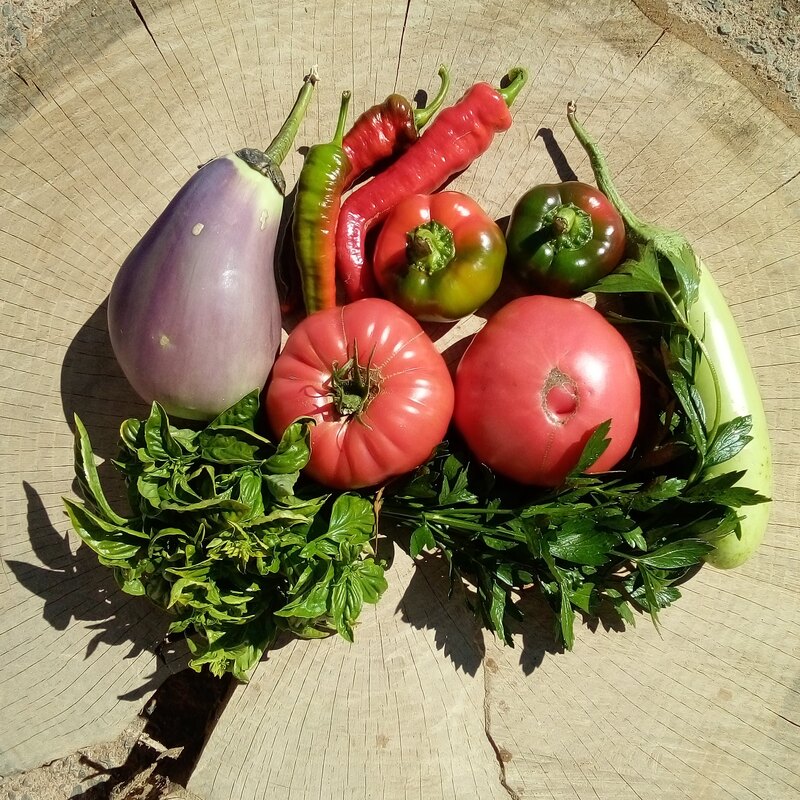
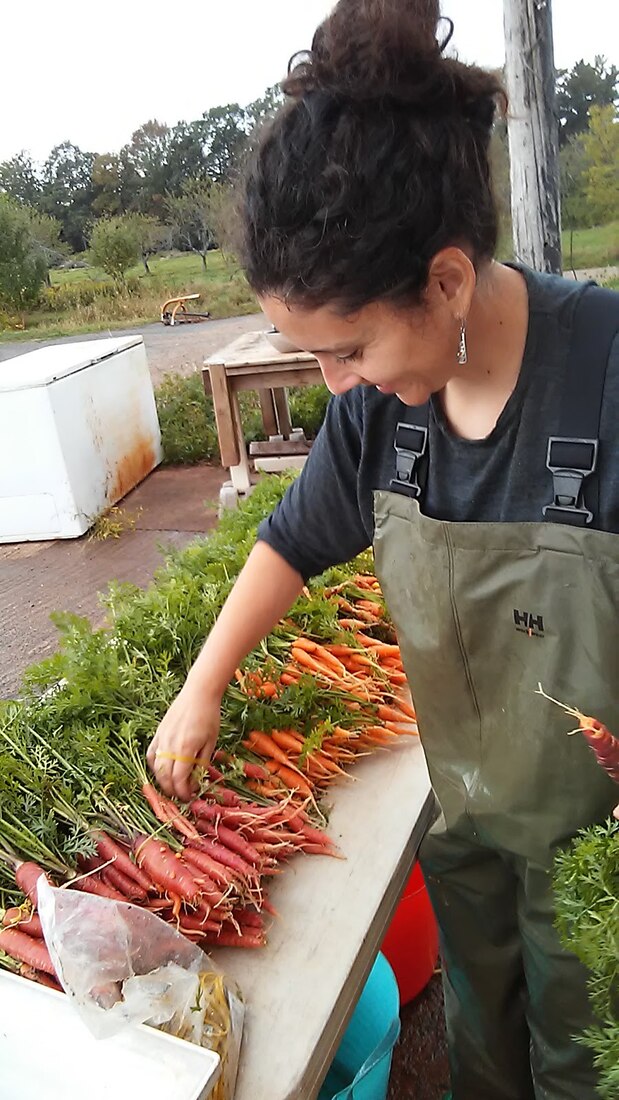


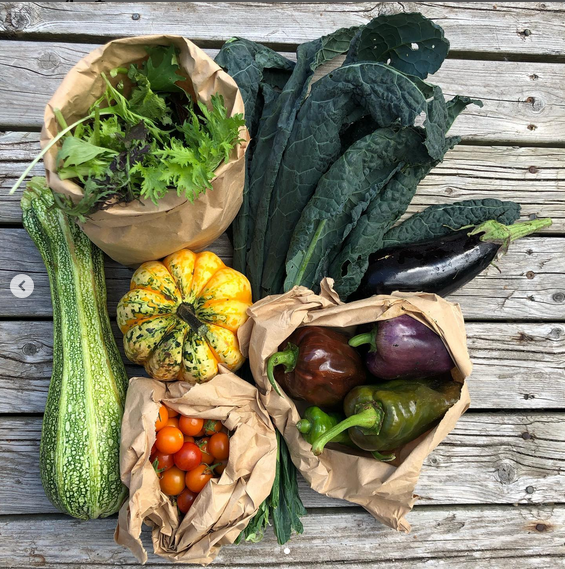
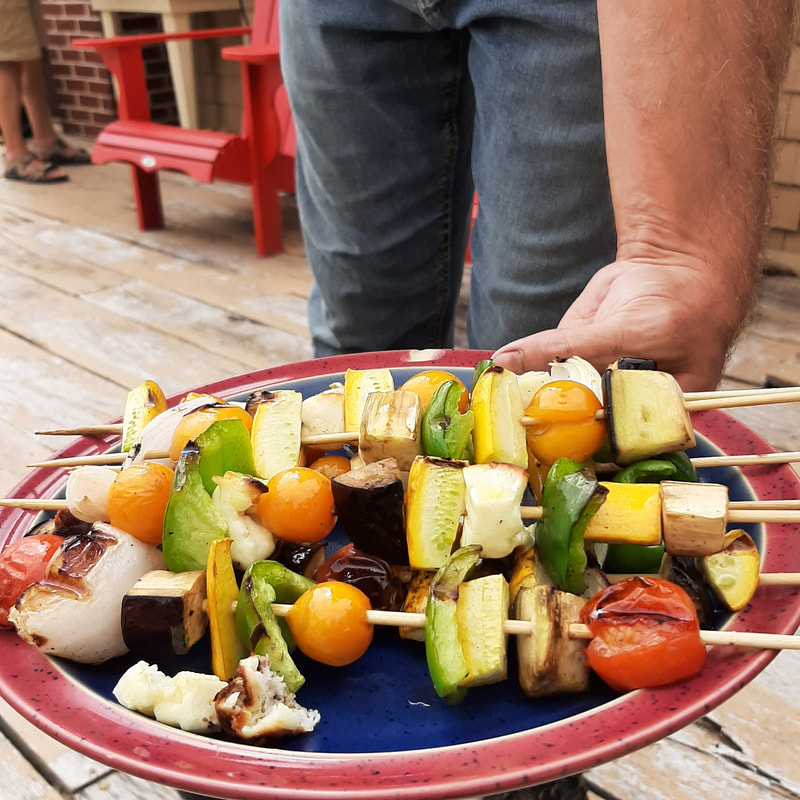











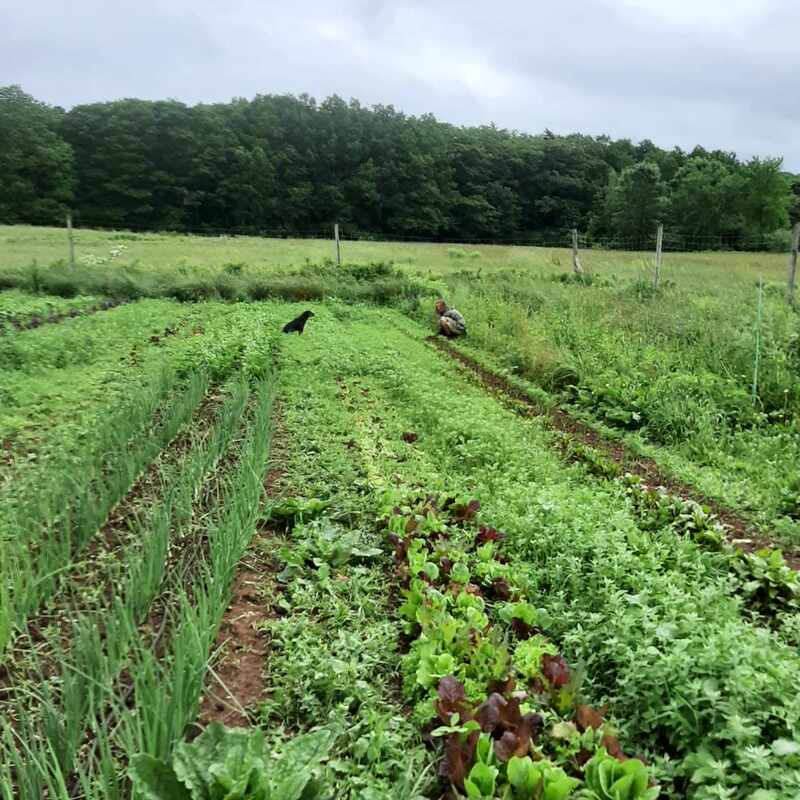


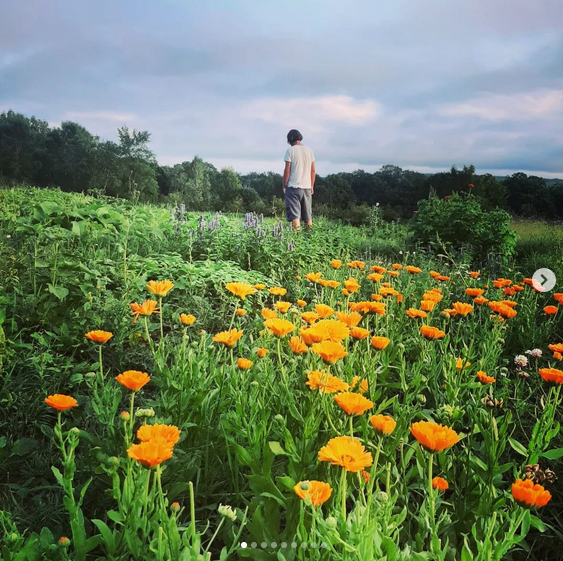









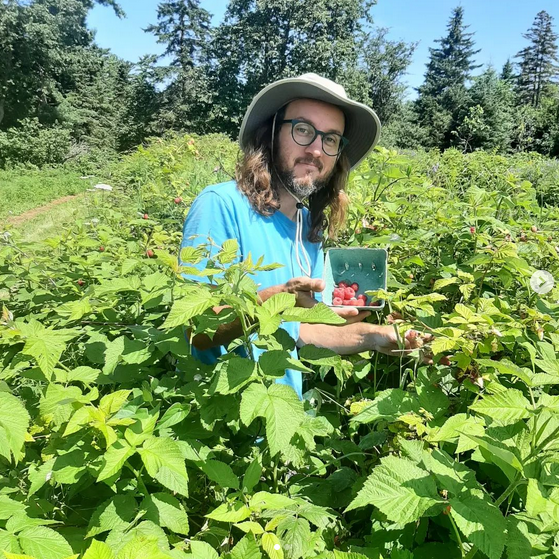


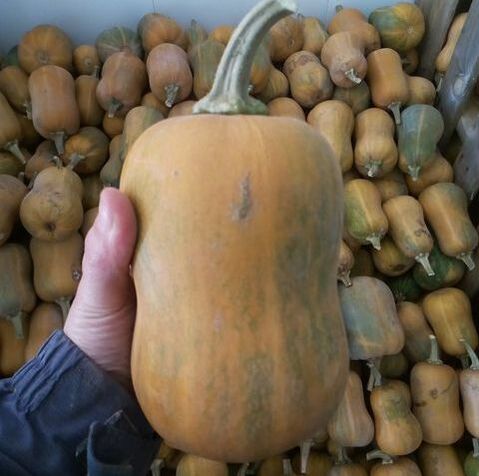


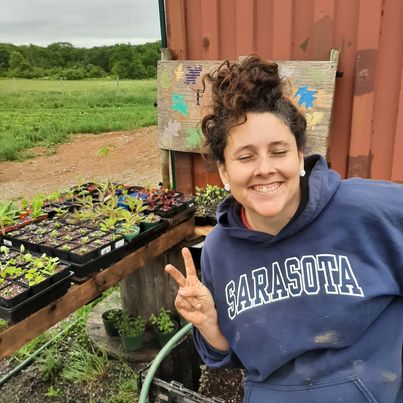





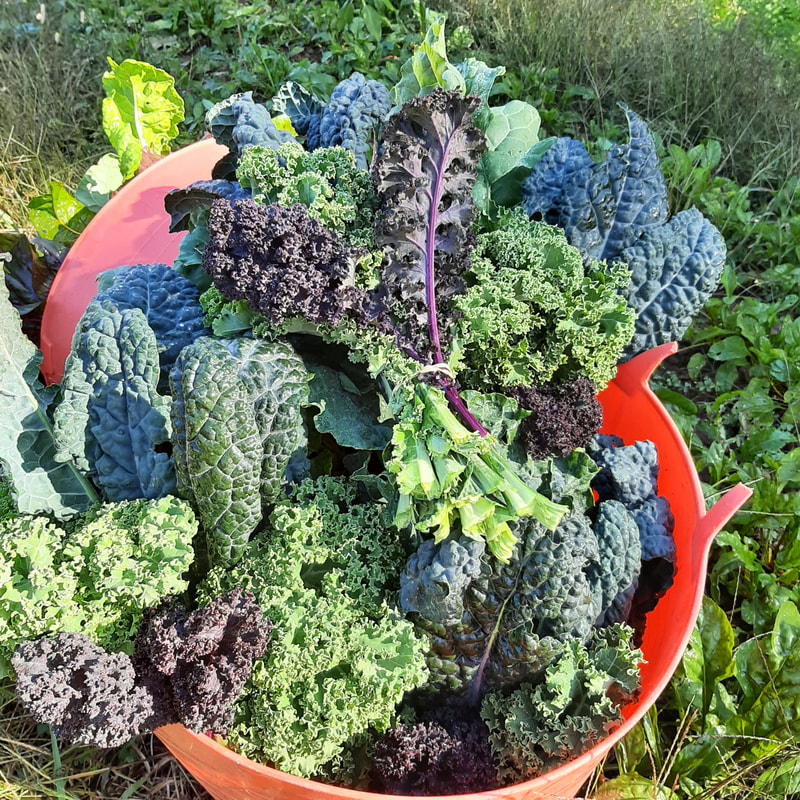
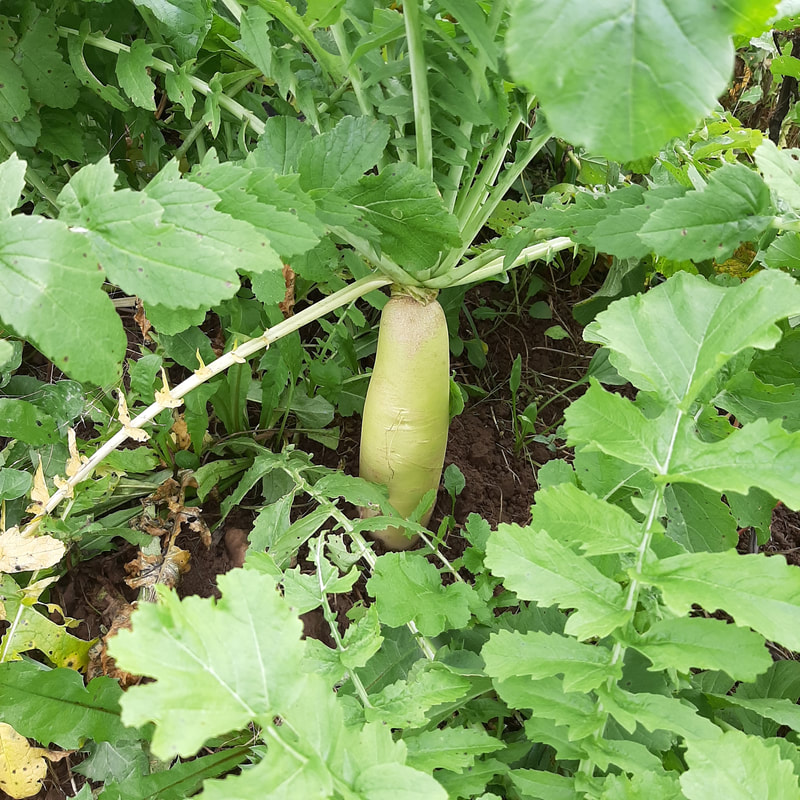

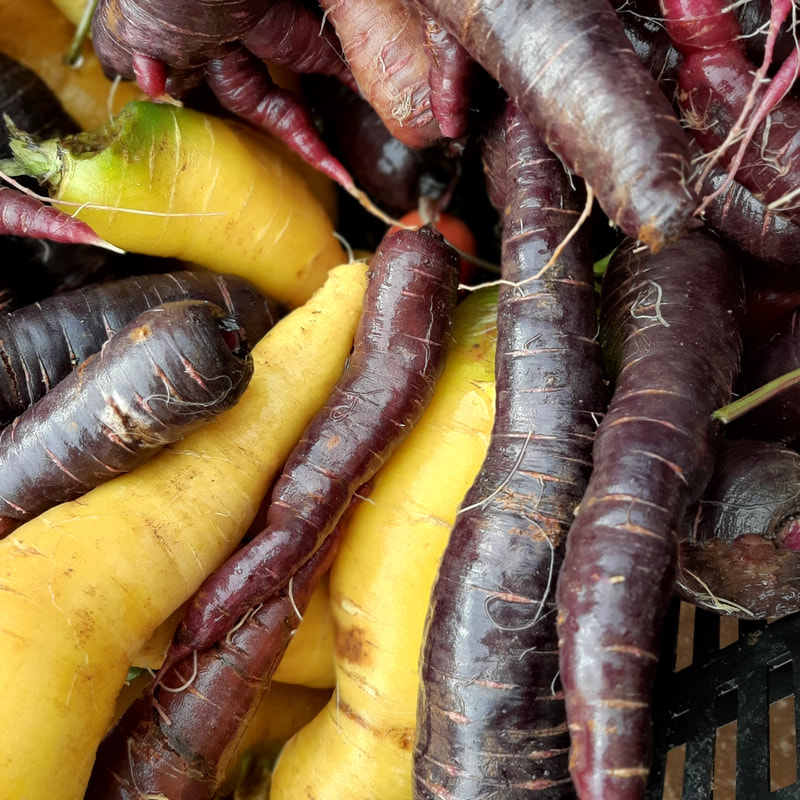







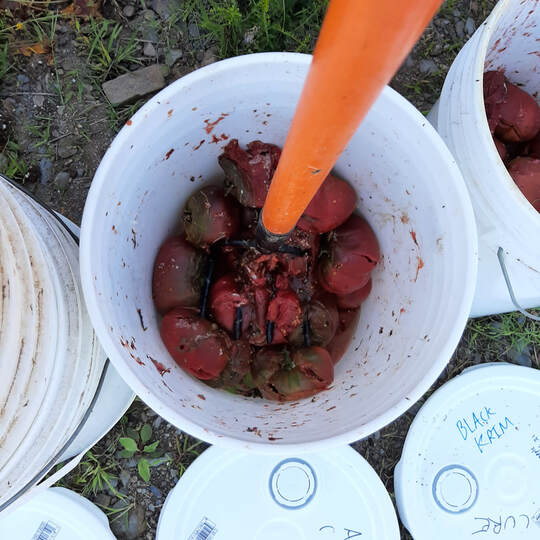
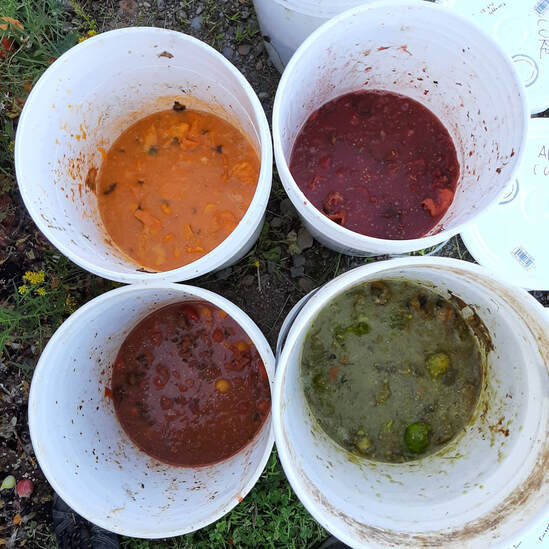
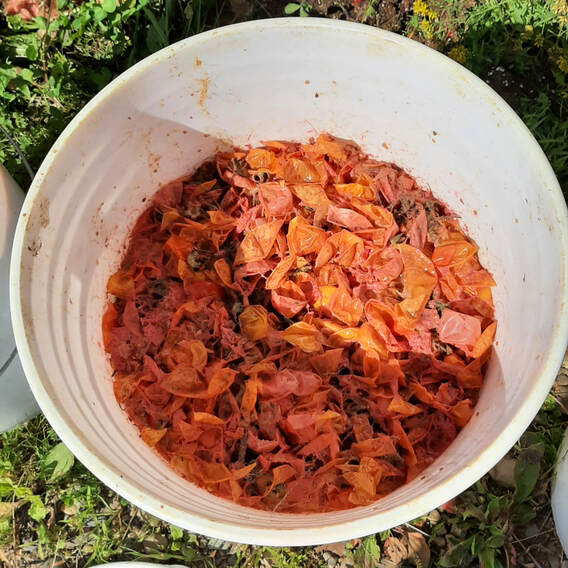



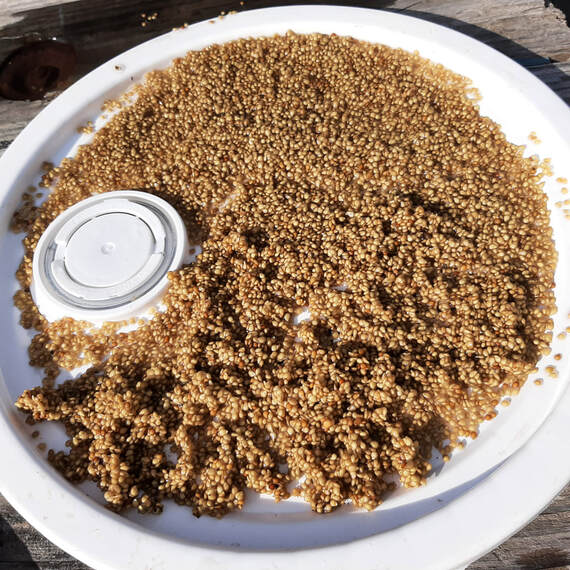




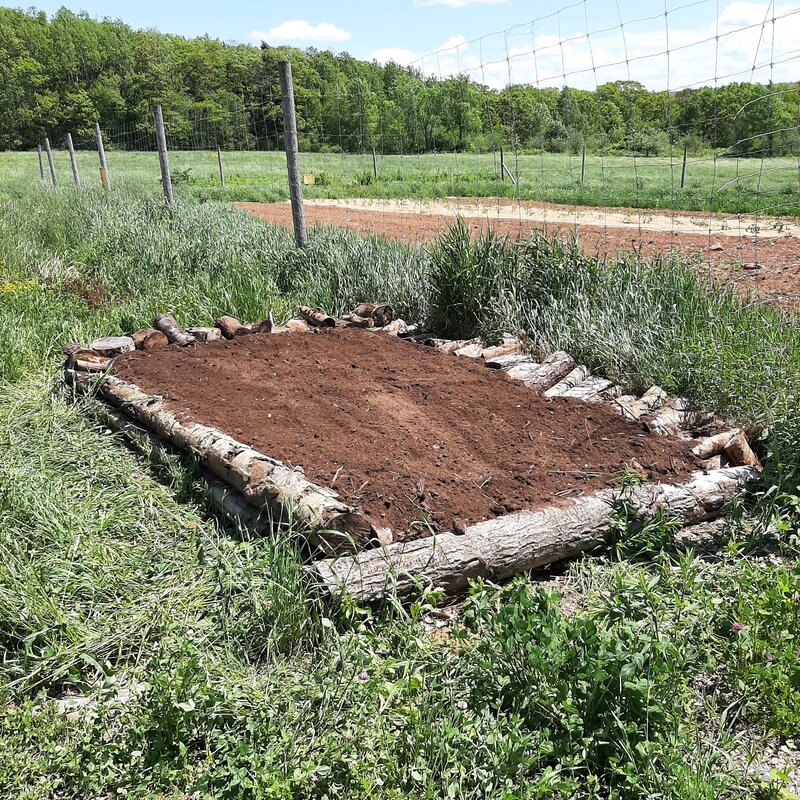






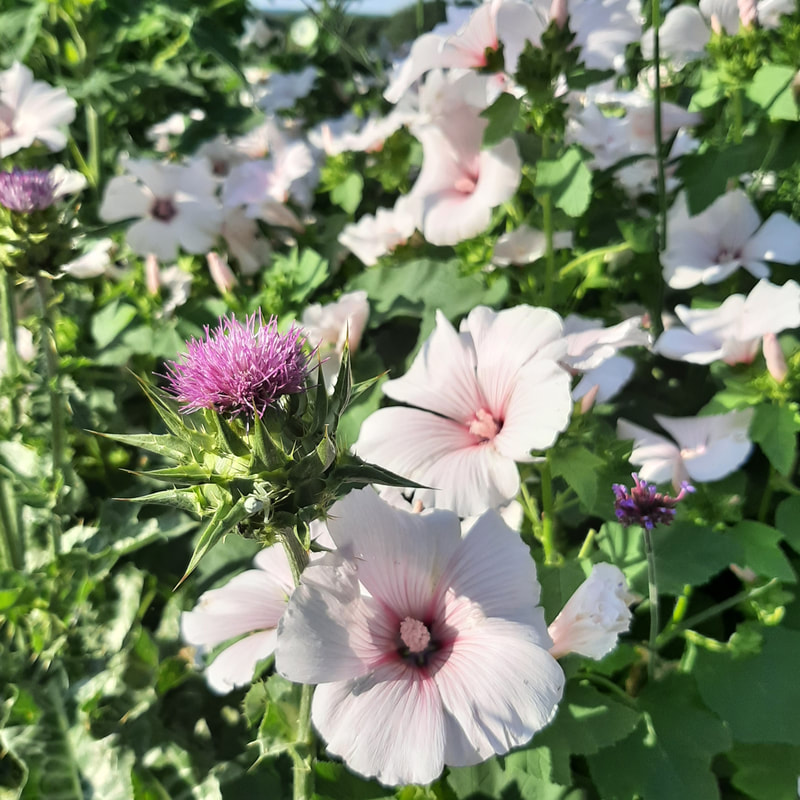












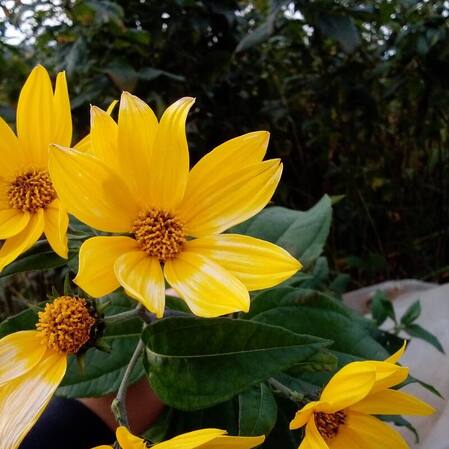


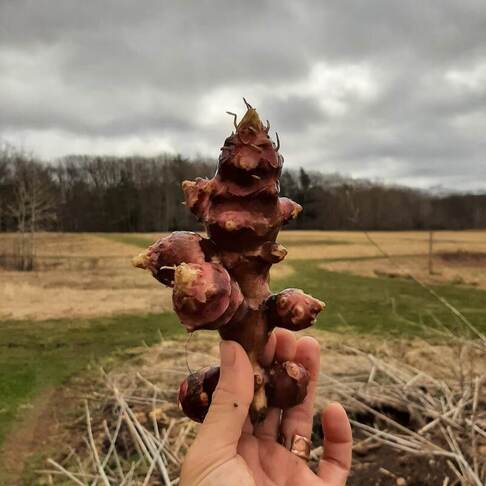
 RSS Feed
RSS Feed